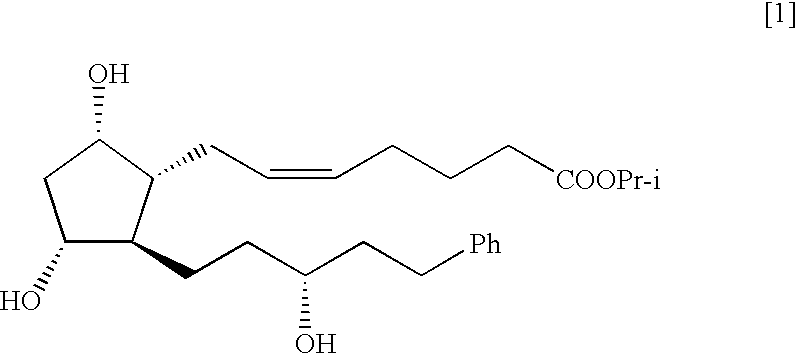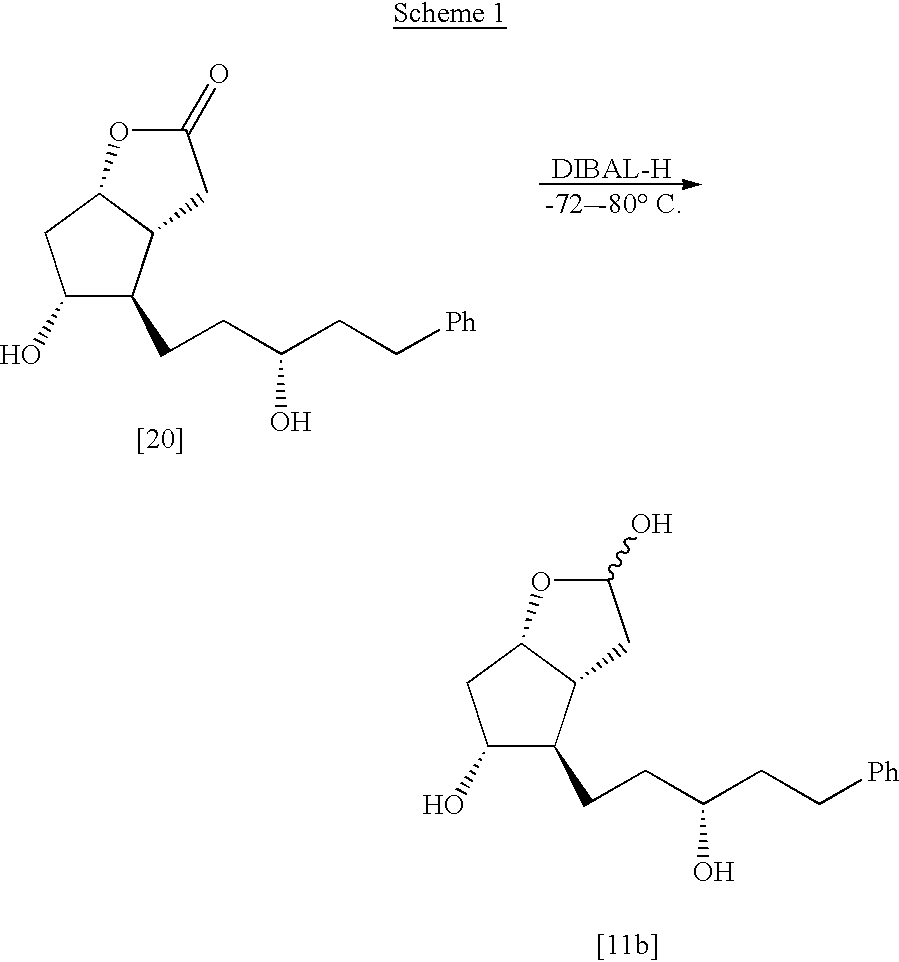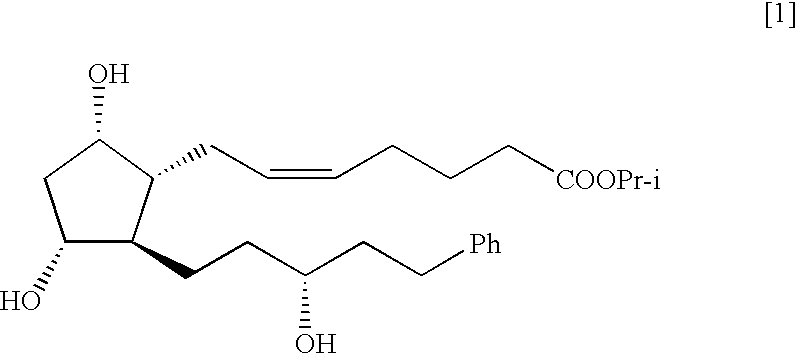Process for the preparation of latanoprost
a technology of latanoprost and process, which is applied in the preparation of carboxylic compounds, drug compositions, organic chemistry, etc., can solve the problems of inability to scale up this highly exothermic reaction and undesired process in product reduction
- Summary
- Abstract
- Description
- Claims
- Application Information
AI Technical Summary
Benefits of technology
Problems solved by technology
Method used
Image
Examples
example 2
(3aR,4R,5R,6aS)-Hexahydro-5-(p-phenylbenzoyloxy)-4-[(3S)-5-phenyl-3-[(tetr-ahydro-2H-pyran-2-yl)oxy]-1E-pentenyl]-2H-cyclopenta[b]furan-2-one [7a]
[0055] 23
1) Preparation of (3aR,4R,5R,6aS)-hexahydro-4-[(3S) and (3R)-3-hydroxy-5-phenyl-1E-pentenyl]-5-(p-phenylbenzoyloxy)-2H-cyclopenta-[b]furan-2-ones [5a] and [6a]
[0056] A solution of (-)-B-chlorodiisopinocamphenylborane (26.0 g) in THF (150 mL) was added dropwise at -23--25.degree. C. to a stirred solution of the compound [4a] (26.0 g) in THF (250 mL). The mixture was stirred at this temperature during 8 h (TLC monitoring) and then quenched by adding 30 mL of Methanol at -23--25.degree. C. The resulting solution was allowed to warm to room temperature and was stirred at this temperature for 14 h. The mixture was concentrated to a volume 70-100 mL and dichloromethane (400 mL) and water (200 mL) were added to it. The organic layer was separated, water layer was extracted with dichloromethane (3.times.100 mL). The combined organic layer...
example 3
(3aR,4R,5R,6aS)-Hexahydro-5-(p-phenylbenzoyloxy)-4-[(3R)-5-phenyl-3-[(tetr-ahydro-2H-pyran-2-yl)oxy]pentyl]-2H-cyclopenta[b]furan-2-one [9a]
[0063] 24
[0064] A mixture of a compound [7a] (80.0 g), palladium on carbon catalyst (16 g) and ethyl acetate (1.0 L) was stirred under hydrogen atmosphere at 150 psi for 3 hours at room temperature. The reaction mixture was then filtered and evaporated under reduced pressure. The oily residue was crystallized from a mixture of hexane and ethyl acetate 4:1 v / v to give 71.4 g (89% yield) of compound [9a], mp 103-105.degree. C., [.alpha.].sub.D.sup.20 -107.degree. (c 1.0, MeCN). .sup.1H NMR (CDCl.sub.3) .delta.: 8.03 (d, J=8 Hz, 2H); 7.60-7.67 (m, 4H); 7.36-7.48 (m, 3H); 7.14-7.24 (m, 5H); 5.20-5.30 (m, 1H); 5.00-5.15 (m, 1H); 4.50-4.70 (m, 1H), 3.89-3.95 (m, 1H); 3.66-3.72 (m, 1H); 3.45-3.50 (m, 1H). .sup.13C NMR (CDCl.sub.3) .delta.: 20.1; 25.4; 28.7; 31.3; 31.9; 36.5; 43.5; 52.8; 63.0; 76.0; 80.1; 84.3; 97.8; 125.7; 127.1; 127.2; 128.1; 128.3; 1...
example 4
(3aR,4R,5R,6aS)-3-Hexahydro-5-(p-phenylbenzoyloxy)-4-[(3S-5-phenyl-3-[(tet-rahydro-2H-pyran-2-yl)oxy]pentyl]-2H-cyclopenta[b]furan-2-one [22]
[0065] 25
[0066] A mixture of a compound [8a] (1.4 g), palladium on carbon catalyst (0.56 g) and ethyl acetate (40 mL) was stirred under hydrogen atmosphere at 40 psi for 3 hours at room temperature. The reaction mixture was then filtered and evaporated under reduced pressure. The oily residue was purified by column chromatography on silica gel elution with mixture of hexane and ethyl acetate 2:1 v / v to give 1.2 g (86% yield) of compound [22] as oil, [.alpha.].sub.D.sup.20 -52.30 (c 1.0, MeCN). .sup.1H NMR (CDCl.sub.3) .delta.: 1.41-1.86 (m, 12H); 2.00-2.25 (m, 1H); 2.34-3.00 (m, 7H); 3.40-3.60 (m, 1H); 3.60-3.80 (m, 1H); 3.80-4.00 (m, 1H); 5.00-5.15 (m, 1H); 4.50-4.70 (m, 1H); 3.89-3.95 (m, 1H); 3.66-3.72 (m, 1H); 3.45-3.50 (m, 1H).
PUM
| Property | Measurement | Unit |
|---|---|---|
| Angle | aaaaa | aaaaa |
| Angle | aaaaa | aaaaa |
| Temperature | aaaaa | aaaaa |
Abstract
Description
Claims
Application Information
 Login to View More
Login to View More - R&D
- Intellectual Property
- Life Sciences
- Materials
- Tech Scout
- Unparalleled Data Quality
- Higher Quality Content
- 60% Fewer Hallucinations
Browse by: Latest US Patents, China's latest patents, Technical Efficacy Thesaurus, Application Domain, Technology Topic, Popular Technical Reports.
© 2025 PatSnap. All rights reserved.Legal|Privacy policy|Modern Slavery Act Transparency Statement|Sitemap|About US| Contact US: help@patsnap.com



